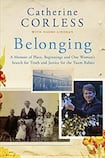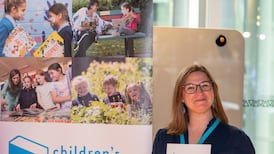
Catherine Corless has become a national and international figure since her extraordinary research work on the Tuam mother and baby home, and her ongoing advocacy for survivors and relatives of those who inhabited that institution.
Corless grew up beside the home and went to school with some of the children who lived there. Later in life she became interested in the history of the home after doing a local history course, and set out to write about its origins and development.
In December 2012 she published a piece in the Tuam Historical Journal that laid out the general history of the home. She also detailed the discovery of the bones of infants and children in a sewage tank in the grounds by some boys in the 1970s. She also described the initial research she had done to track death records for children who had died in the home.
Corless kept up her research, and eventually determined that 798 children had died in the Tuam home in its 36-year existence, but that burial records existed for only two. Where were the other 796 buried?
In spring 2014 she contacted the media, and a piece appeared in a national newspaper giving the details of her findings. It immediately became a huge national and international story, and led in 2015 to the establishment of the Commission of Investigation into Mother and Baby Homes.
The commission’s report, published in January 2021, caused widespread dismay, distress and shock to survivors whose testimonies had been drastically reduced. Its conclusions with regard to physical abuse, forced adoptions, and attribution of blame to women’s families for their incarceration in these institutions were forcefully rejected by survivors, journalists and advocates’ groups.
Corless's unstinting efforts, like those of Mary Raftery and survivors of industrial schools 20 years before, eventually led to the establishment of a commission of investigation
When Corless appeared on The Late Late Show in spring 2017, the country saw a diffident, modest woman who was obviously uncomfortable with adulation, but whose commitment to the children who died and those who survived, their mothers and their relatives was heartfelt and profound.
This book is important for two reasons. First, it brings us through Corless’s journey towards the explosive revelations about the children buried in the grounds of the Tuam home, and the ensuing battle to have this tragedy dealt with properly, including the exhumation and reburial of their remains, and the provision of information to their relatives. Second, it tells a very moving and extraordinarily personal story about Corless’s relationship to her own mother, and the mental health problems it caused her in midlife.
The difficult attempt to find out as much as she could about the fate of the 796 children for whom there were no burial records made Corless into an expert researcher. She found her way through newspapers, genealogical websites, maps of Tuam, and eventually, the records of Galway County Council – records to which she was initially refused access because she was “not an academic”, and which eventually revealed that the council had known for decades that children were buried on the site of the home, and had done nothing about it.
A huge body of material
As Corless pursued her inquiries, she began to meet Tuam survivors, many of whom had been boarded out to uncaring homes as children, and who were really anxious to find their birth mothers and possible siblings. Her focus began to include the living survivors as well as the dead children. She amassed a huge body of material, including valuable personal testimonies from mothers, children and workers who had been in the home. Her unstinting efforts, like those of Mary Raftery and survivors of industrial schools 20 years before, eventually led to the establishment of a commission of investigation.
We know the outlines of this story already, but Corless fleshes it out with individual accounts from some of the many survivors whom she met and, in some cases, helped to find their families with her considerable genealogical skills.
For example, she describes the experience of "Nora", who attempted to find
her birth mother through Tusla, the Child and Family Agency. Nora was told her mother did not wish to meet her, only to discover sometime later that her mother had never heard from Tusla. This is just one example of the constant obstruction survivors have faced from church and State in their search for their identities. Luckily, Nora did find her family, again with Corless's help.
The story of Corless’s relationship with an emotionally damaged mother, the panic attacks, anxiety and depression she suffered later in life, leading to therapy, medication and electroshock treatment, is incredibly honest about how unloved she felt as a child, and how crucially important her husband, Aidan, and her four children were to her as a result.
Her insistence on proper burials for the children has deep roots in Irish respect for the dead, and she will not rest until they are interred properly
Corless later discovered that her mother had been born outside marriage and fostered out during her childhood, initially to abusive families, finally to a loving one. This allowed her to understand why her mother was so emotionally withdrawn – she had never learned how to give or receive love, and was consumed with corrosive shame about her origins.
The two stories are linked: Corless’s passion for the Tuam children and their mothers and other relatives is definitely linked to her own experience of what she perceived as maternal abandonment. Though she had not been forcibly removed from her mother, she understood some of the trauma undergone by women who had suffered this fate, and children left motherless.
Her insistence on proper burials for the children has deep roots in Irish respect for the dead, and she will not rest until they are interred properly, in the same way as bodies found during archaeological digs are. She constantly asks: what is the difference between the Tuam children’s bodies and others improperly buried? As yet, that question has not been answered.
Corless has done us a great favour in her relentless campaign to give voice to the voiceless, and for being so incredibly honest about her own experience of mental health difficulties. With the latter, she has opened up another taboo subject that badly needs airing.
Most of the trauma which sometimes seems to overwhelm our society is due to shame and silence. Catherine Corless has banished shame and broken the silence. For that, we owe her a great debt.
Catriona Crowe is a historian and archivist










